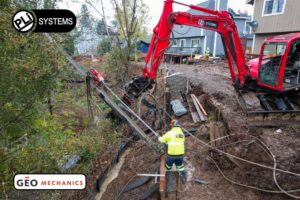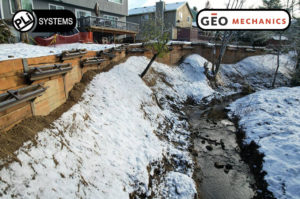Slope Stabilization in Gresham, Oregon
GEOMechanics was retained by geotechnical contractor, PLI Systems, to assist the City of Gresham, Oregon to stabilize a failing 25-foot-high steep slope behind three private residential homes along SE Greenway Drive. A landslide occurred behind one of the residences in June 2022 and the slopes behind the other two residences exhibited evidence of past instability and were determined to be at similar risk of failure.
Subsurface conditions at the site generally consist of up to 5 feet of silty fill and 20 feet of soft silt and clay underlain by dense sand and gravel. The fill was likely placed to create a graded surface to build the homes. The geotechnical report indicated that the sources of slope instability were likely from a combination of improperly placed fill soils, groundwater flow below the slope, and erosion of the slope toe from Kelly Creek during high flow events.
 GEOMechanics and PLI Systems stabilized the slope using a tied-back soldier pile and timber lagging retaining wall. To resist local stability, the soldier pile wall was designed to support the exposed height of the existing landslide head scarps and future erosion at the bottom of the wall was included. The soldier piles were also designed to provide shear resistance across potential slope failure surfaces, thereby providing resistance against local and global instability.
GEOMechanics and PLI Systems stabilized the slope using a tied-back soldier pile and timber lagging retaining wall. To resist local stability, the soldier pile wall was designed to support the exposed height of the existing landslide head scarps and future erosion at the bottom of the wall was included. The soldier piles were also designed to provide shear resistance across potential slope failure surfaces, thereby providing resistance against local and global instability.
Based on the subsurface investigation, experience, site visits, and knowledge of local conditions, GEOMechanics calibrated the soil properties in their slope stability model to match the observed field conditions. This approach reduced soldier pile and tieback requirements and therefore provided significant cost savings for the City of Gresham.
 The final design utilized W12x45 soldier piles driven into the dense sand and gravel located approximately 30 feet below the existing ground surface. GEOMechanics estimated that future downslope erosion could result in the soldier piles supporting an exposed height of up to 12 feet, and designed the wall accordingly. Additionally, driving the soldier piles into the dense sand and gravel results in acceptable factors of safety against static and seismic global instability.
The final design utilized W12x45 soldier piles driven into the dense sand and gravel located approximately 30 feet below the existing ground surface. GEOMechanics estimated that future downslope erosion could result in the soldier piles supporting an exposed height of up to 12 feet, and designed the wall accordingly. Additionally, driving the soldier piles into the dense sand and gravel results in acceptable factors of safety against static and seismic global instability.
Tiebacks were installed at each soldier pile location to assist with local and global stability. Helical anchor tiebacks were initially considered, but due to the need for embedment into the dense sands and gravels, the design was adjusted to utilize hollow bar tiebacks, which can drill through obstructions easier than helical anchors. The ability to quickly adapt to field conditions by redesigning the tiebacks resulted in a smooth and cost-effective project delivery.
GEOMechanics also provided special inspection services during construction to confirm the subsurface conditions, review for drawing compliance, observe tieback proof testing, and provide field recommendations.






